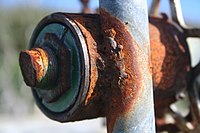
Photo from wikipedia
A comparative study was performed to investigate the NH3-selective catalytic reduction (SCR) reaction activity of Cu-SSZ-13 zeolites having Si/Al ratios (SARs) of 5, 18, and 30. Remarkably, the Cu-SSZ-13 zeolite… Click to show full abstract
A comparative study was performed to investigate the NH3-selective catalytic reduction (SCR) reaction activity of Cu-SSZ-13 zeolites having Si/Al ratios (SARs) of 5, 18, and 30. Remarkably, the Cu-SSZ-13 zeolite catalysts exhibited completely opposite behaviors as a function of SAR under standard SCR (SSCR) and fast SCR (FSCR) reaction atmospheres. Under SSCR conditions, the NOx conversion increased as expected with the decreasing SAR. Under FSCR conditions, however, the NOx conversion decreased as the SAR decreased, contrary to expectations. In this study, based on characterization of the catalysts by X-ray diffraction, transmission electron microscopy, electron paramagnetic resonance, H2-temperature-programmed reduction, temperature-programmed desorption, and diffuse reflectance infrared Fourier transform spectroscopy, together with theoretical calculations, the authors found that the amount of Brønsted acid sites goes up while the SAR goes down, leading to an increase in the accumulation of NH4NO3 under FSCR reaction conditions. Moreover, the accumulated NH4NO3 is of greater stability for those low SAR Cu-SSZ-13 catalysts. These two reasons cause the FSCR performance of Cu-SSZ-13 to decrease with a decrease in SAR. As a result, the NO2 effect on SCR activity changes from promotion to inhibition as the SAR decreases.
Journal Title: Environmental science & technology
Year Published: 2022
Link to full text (if available)
Share on Social Media: Sign Up to like & get
recommendations!